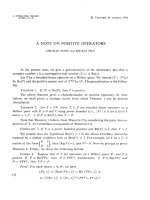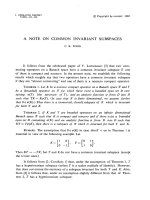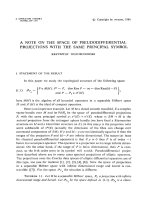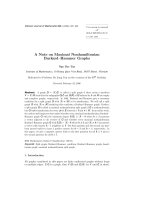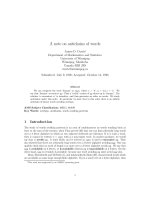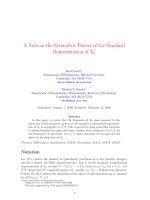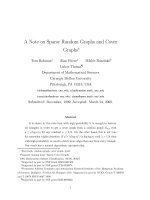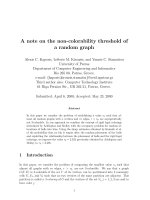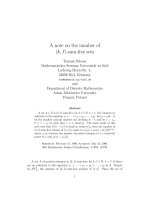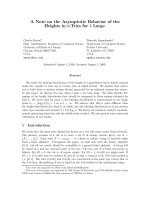Báo cáo toán học: "A Note on Divisibility of the Number of Matchings of a Family of Graphs" ppt
Bạn đang xem bản rút gọn của tài liệu. Xem và tải ngay bản đầy đủ của tài liệu tại đây (73.6 KB, 4 trang )
A Note on Divisibility of the Number of Matchings
of a Family of Graphs
Kyung-Won Hwa ng
General Education Department, Kookmin University
861-1 Jeongneung-dong Seongbuk-gu 136-702, South Korea
Naeem N. Sheikh
Department of Mathematics and Statistics, Miami University
Oxford, OH 45056
Stephen G. Hartke
∗
Department of Mathematics, University of Nebraska-Lincoln
203 Avery Hall, P.O. Box 880130, Lincoln, NE 68588-0130, USA
Submitted: May 8, 2006; Accepted: Mar 9, 2007; Published: Mar 20, 2009
Mathematics Subject Classification: 05A15
Abstract
For a certain graph obtained by adding extra vertices and edges to the triangular
lattice graph, Propp conjectured that the number of perfect matchin gs of such a
graph is always divisible by 3. In this note we pr ove this conjecture.
In a graph G, a matching is a set of edges such that no two edges are incident to each
other. A matching in a graph is called perfect if every vertex is incident with an edge of the
matching. In particular, graphs on an odd number of vertices have no perfect matchings.
Many different problems of matchings have been studied: existence, construction, and
enumeration are three big categories of problems involving matchings.
For a somewhat detailed history of the task of enumerating perfect matchings of dif-
ferent graphs, we refer the reader to the intro duction section in Propp [1]. Researchers
∗
Research partially supported by a Maude Hammond Fling Faculty Research Fellowship from the
University of Nebraska Research Council.
the electronic journal of combinatorics 16 (2009), #N10 1
Figure 1: The graph G
3
.
have focused special a tt ention on this problem when the graphs in question are planar,
have a repeating pa tt ern and/or have a g eometric description. Some important families of
graphs in t his regard are two-dimensional grids [2, 3], Aztec diamonds [4], and honeycomb
graphs [5]. A reason this has attracted considerable interest, from both mathematicians
and specialists in other areas, is that a matching can represent a phenomenon in a number
of settings. For example, a perfect matching in a two dimensional lattice of molecules
could represent the way atoms pair up under the forces of hydrogen bonding.
When finding a formula for the number of perfect matchings of a graph has seemed
hard, researchers have focused o n the questions of divisibility of the number of perfect
matchings by powers of various small primes. Sometimes there is a compact formula for
the number of mat chings, but it involves irrational numbers (for example, for the number
of matchings of a rectangular grid-graph as found in [2]) and thus information about
divisibility by particular integers is hard to extract.
In this paper, we consider the planar graph G
n
obtained from the triangular lattice
with n rows of triangles by adding extra vertices and edges in the triangular faces pointing
“upwards”, as shown in Figure 1. James Propp [1] conjectured that the number of perfect
matchings of G
n
is always a multiple of 3. Let M(G
n
) denote the number of perfect
matchings of G
n
. We prove Propp’s conjecture, and in fact prove that 3
n+1
2
divides
M (G
n
). We also prove that there is an extra factor of 3 when n is 0 mod 3. Note
that for even n, the number of vertices in G
n
is odd a nd hence M (G
n
) = 0 for such
a graph. Doug Lepro solved the same pro blem in his unfinished Ph.D. thesis – a work
which is unpublished and dates back more than six years. We also note that our method
of proof is somewhat similar to the metho d employed by Pachter in [6] in which he proves
divisibility by powers of 2 for the number of matchings of the square grid graph.
Theorem 1 For n odd, the number of perfect matchings of G
n
is a multiple of 3
n+1
2
.
Proof. We use the term block to refer to a triangular face of the triangular lattice in
which there is an extra vertex and three extra edges. Thus, G
n
can be seen as a triangular
arrangement of edge-disjoint blocks some of which share vertices with others. Given a
the electronic journal of combinatorics 16 (2009), #N10 2
Figure 2: Examples of blocks. The block on the right contains a matching of two edges
(shown in bold) and hence is internally satisfied.
perfect matching of G
n
, we call a particular block internally satisfied if it contains two
edges of the perfect matching (i.e. the four vertices in the block are matched to vertices
within the block). Figure 2 illustrates the concept of a block and an internally satisfied
block. First we note that a block itself can be internally satisfied in 3 different ways (as
the reader may have observed, a block is isomorphic to the graph K
4
, and K
4
on la beled
vertices has 3 perfect matchings). The main observation is that when a block is internally
satisfied in a perfect matching, then changing the pairing within the block to either of the
other two ways still gives us a perfect matching of the overall graph.
Counting the number of vertices in G
n
by rows from top to bottom, we see that the
total number of vertices in G
n
is 2(1 + 2 + + n) + n + 1 = n(n + 1) + n + 1. Therefore,
the number of edges in a perfect matching of G
n
is
1
2
n(n +1) +
n+1
2
. The numb er of blocks
in G
n
is 1 + 2 + + n =
1
2
n(n + 1).
Now, note that in any perfect matching of G
n
, each block must contain at least one
edge of the matching, because the center vertex in each block can be paired only with one
of the other 3 vertices of the block. Furthermore, each block can have at most two edges
of any perfect matching (since each block has 4 vertices). Since the number of edges in
any perfect matching is
n+1
2
more than the number of blocks, we have that in any perfect
matching exactly
n+1
2
blocks have two edges. In other words, in any perfect matching,
exactly
n+1
2
blocks will be internally satisfied.
Now, consider the set of all perfect matchings of G
n
. Define a relation R on this
set as follows: two perfect matchings have the relation R if and only if they have the
same set of
n+1
2
internally satisfied blocks and their edges outside these blocks are the
same. It is easily seen that this binary relation is an equivalence relation on the set of all
perfect matchings of G
n
. Now, we claim that each of the equivalence classes under R has
cardinality 3
n+1
2
. Thus, the total number o f perfect matchings is a multiple of 3
n+1
2
.
It remains o nly to prove the claim that each equivalence class has cardinality 3
n+1
2
.
This follows from our earlier observation: each o f the internally satisfied blocks can be
rematched in any of the 3 ways without disturbing the remaining matching. Since each
of the
n+1
2
blocks can be rematched independently in three different ways, it follows that
each equivalence class has cardinality 3
n+1
2
.
the electronic journal of combinatorics 16 (2009), #N10 3
Theorem 2 For n odd, and n congruent to 0 mod 3, the number of perfect matchings of
G
n
is a multiple of 3
n+3
2
.
Proof. We start with the set of equivalence classes under the relation R defined above
and construct an equivalence relation T on this set. First note that a given equivalence
class under R is determined by specifying the
n+1
2
internally satisfied blocks and by spec-
ifying the edges in the matching that are outside the internally satisfied blocks. We use
the term pattern to mean the specification for an equivalence class under R (we visualize
this by coloring the blocks that a re internally satisfied with gray color) . We say that two
such patterns are related under the relation T if one can be obtained from the other by
rotation through 0, 120 or 240 degrees. Note that T is a n equivalence relation.
We now show that each equivalence class under T has cardinality 3. In other words,
there is no pattern that is fixed under rotation by 120 or 240 degrees. Observe that when
n is 0 mod 3 and n is an odd number, there is no centrally-located block in G
n
. If a
pattern were to be fixed under rotation by 120 or 24 0 degrees, it would have t o have the
number of internally-satisfied blocks be a number that is a multiple of 3. However,
n+1
2
is not divisible by 3 if n is 0 mod 3. Thus no pattern is fixed under rotation by 120 or
240 degrees. Hence, every equivalence class under T has cardinality 3. Given that each
pattern is itself an equivalence class of size 3
n+1
2
and the number of patterns is divisible
by 3, we have that 3 × 3
n+1
2
= 3
n+3
2
divides M (G
n
).
Acknowledgements
We thank Professor Alexandr Kostochka for useful comments. We also thank the anony-
mous referee for improvements, and for po inting out Doug Lepro’s work and the wor k by
Pachter.
References
[1] J. Propp, Enumeration of Matchings: Problems and Progress, New Perspectives in
Geometric Combinatorics, MSRI Publications, 38, (1999) 25 5-291.
[2] P. W. Kasteleyn, The statistics of dimers on a lattice I: The number of dimer ar-
rangements on a quadratic lattice, Physica, 27, (1961), 1209-1225.
[3] H. N. V. Temperley and M. E. Fisher, Dimer problem in statistical mechanics – an
exact r esult, Phil. Mag., 6, (1961), 1061-1063.
[4] N. Elkies, G. Kuperberg, M. Larsen, and J. Propp, Alternating sign matrices and
domino tilings, J. Algebraic Combin., 1, (1992), 111-132 and 21 9-234.
[5] G. Kuperberg, Symmetries of plane partitions and the permanent-determinant
method, J. Combi n. Theory Ser. A, 68:1, (1994), 1 15-151.
[6] L. Pachter, Combinato r ia l approa ches and conjectures for 2-divisibility problems con-
cerning domino tilings of polyominoes, Electron. J. Combin., 4 (1), (1997), R2 9.
the electronic journal of combinatorics 16 (2009), #N10 4
